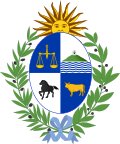Television in Uruguay
Parts of this article (those related to documentation) need to be updated. (September 2013) |
This article needs additional citations for verification. (December 2007) |
| This article is part of a series on the |
| Culture of Uruguay |
|---|
 |
|
Uruguay Portal |
Analog television in Uruguay had a history of more than 50 years since it began in 1956, with the first television channel, Channel 10. Since then Uruguay has three other channels, Channel 12 Teledoce, Channel 4 Monte Carlo TV and Television Nacional Uruguay
Cable television
[edit]Cable television is largely controlled by the Equital conglomerate, founded in 1991, which is owned in equal parts by the three private television stations of Montevideo. Each network owns a cable company: Teledoce owns Nuevo Siglo, Monte Carlo, Montecable and SAETA, TCC. The tripartite conglomerate monopolizes pay television in Montevideo and parts of the inland, controlling at least one of the two providers available in Colonia del Sacramento, Salto, Paysandú, Treinta y Tres, Melo, Durazno, Minas, Rocha and Tacuarembó. Equital has been accused of cartelization and has been investigated by URSEC in the first half of the 2000s for collusion and price control.[1][2]
Digital television
[edit]On August 27, 2007, the Uruguayan government issued a decree stating that the DVB-T and DVB-H standards would be adopted.[3][4] On February 17, 2011, the government issued a new decree revoking the former one, and selecting ISDB-T as the standard to be adopted.[5][6] Uruguay hoped for neighboring countries to reach an agreement on an HDTV standard, but so far[when?] that does not seem to be the case.
- Brazil adopted the ISDB-T system in November 2007 after a very extensive and consistent study (executed by Mackenzie University and Television Engineering Association) where ISDB-T standard presented a more robust signal, more flexible services including mobile TV reception for free and excellent user interactive services. The implementation rollout through the country has been very successful.[clarification needed] The prices of digital TV receivers and set-top boxes are rapidly decreasing.[clarification needed]
- In the late 2000s, Argentina was analyzing ISDB-T to verify if the standard also attends their needs. There is a wish to implement only one digital TV standard in all Mercosur Area, and if Argentina chooses ISDB-T it will be an important step for that integration (except for Uruguay and Colombia).
- Uruguayan URSEC authorities[7] provided no information on which road they would go until late in 2007. On August 27, 2007, Ursec settled on DVB-T and DVB-H. The TV sets being sold in Uruguay seem to be closer to ATSC HDTV-based standards (60 Hz systems, with ATSC tuners in some cases). Most of the DVD-based content in the country is NTSC/60 Hz-based, while the TV standard in use is PAL/50 Hz-based. Most of the analog TV sets sold are PAL-N, PAL-M and NTSC-capable, while most DVD players are multiregion. Authorities are not asking retailers to identify which standard the HDTV sets sold adhere to.
- 2010: All subscription television operators offer HDTV premium packages at varying prices. The offers rely on proprietary set-top boxes.
Most viewed channels
[edit]| Position | Channel | Share of total viewing (%) |
|---|---|---|
| 1 | Teledoce | 12.3 |
| 2 | Channel 10 | 9.8 |
| 3 | Channel 4 | 8.9 |
| 4 | Canal 5 | 3.6 |
| 5 | TV Ciudad | 3.3 |
| 6 | La Red | 2.5 |
| 7 | VTV | 2.0 |
| 8 | UCL TV | 1.2 |
| 9 | VTV Plus | 1.0 |
| 10 | Canal A+V | 0.6 |
References
[edit]- ^ [https://www.produ.com/television/noticias/bergara-de-ursec-amerita-evaluar-llamado-a-nuevos-operadores-en-montevideo/ Bergara de Ursec: Amerita evaluar llamado a nuevos operadores en Montevideo ]
- ^ La televisión privada comercial en Uruguay, retrieved April 4, 2025
- ^ "Uruguay" (PDF). Archived from the original (PDF) on 2007-12-05. Retrieved 2007-11-30.
- ^ DVB.org announcement on Uruguay's decision Archived 2008-01-10 at the Wayback Machine
- ^ "Uruguay" (PDF). Retrieved 2014-07-17.
- ^ "Televisión Digital Abierta". Retrieved 2014-07-17.
- ^ "Inicio". Retrieved 12 August 2016.
External links
[edit]- "Uruguay celebra 60 años de TV" (in Spanish). EL PAIS. 4 December 2016. With interviews to Cristina Morán, Julio Sánchez Padilla, Julia Möller, and Cacho de la Cruz.
https://www.amasv.com.uy (in Spanish) https://mediospublicos.uy (in Spanish)
